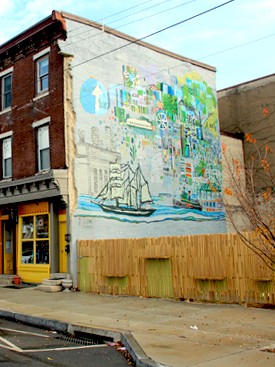Coordinated efforts by community-based organizations, local business owners, and municipal partners can create conditions to revitalize these strips and to spur economic growth by upgrading the physical surroundings, supporting existing businesses, attracting new stores, and improving the reputation of the community as a place to shop. As businesses grow, they provide a wider array of retail options to residents, add jobs in the community, and serve as well-maintained physical anchors, improving the use of public space in the neighborhood. Equally important, the process of working to improve the commercial corridor contributes to an overall increase in civic participation and strengthens the sense of community.1
MetroEdge, a program of the Local Initiatives Support Corporation (LISC),2 strives to develop such commercial corridors and stimulate economic growth. MetroEdge was started nearly 20 years ago by the former ShoreBank in Chicago3 to gather and analyze local economic data to illustrate unmet commercial demand in low-income neighborhoods and to serve as a tool to attract retail investment. MetroEdge uses national and local data from sources such as Nielsen, Esri, and PolicyMap to help communities craft strategies for commercial corridor revitalization, often as part of larger community revitalization efforts.4
In LISC MetroEdge's Corridors of Retail Excellence (CORE) program, one or more members of MetroEdge's experienced team of national economic development consultants work with local LISC offices and their community partners to cultivate viable commercial corridor development strategies in local low- and moderate-income neighborhoods. The consultants collect and analyze the data and provide expertise and advice on commercial corridor strategies and programs, including framing the information and engaging in an interactive dialogue with the local stakeholders to find collective, practical strategies. The CORE program identifies early action projects and helps launch development initiatives. The program has helped communities attract new businesses, boost sales for existing local retail stores and restaurants, bring in new resources, exercise more control over their economic futures, and integrate these efforts with larger community development strategies.
Since MetroEdge became part of LISC in 2006, the program has operated in 50 communities in 16 cities across the country.5 LISC MetroEdge analysis of CORE projects has identified lessons for increasing retail sales, improving tenant mix and occupancy rates, building a corridor organization's administrative capacity for ongoing success, and improving the physical environment of both public space and private property. Following are five key insights from the CORE program.
Pay Attention to Threshold Elements
MetroEdge has operated in communities with vastly different demographics, market assets, political environments, and local capacities. Even with CORE's targeted technical and financial resources, however, not all corridors can be revitalized, nor can they reach the level of MetroEdge's most successful partnerships. Dissection of these case studies led to the following list of local conditions that should be in place before corridor revitalization efforts with the CORE model can be successful:
- Minimum Density: Ideally, convenience markets surrounding targeted corridors need a minimum density of 5,000 households per square mile.
- Accessibility: Corridors must be easily accessible by car and public transit.
- Safety: Residents of the target market should feel safe driving, walking, and living in the area. The corridor should project a sense of safety for business shoppers.
- Existing Retail: Some concentration of fully operating retail must be present as a starting point. This may consist of an intersection with an anchor institution and related commercial uses, for instance, or it could be a block or more of small stores and restaurants.
- Capacity: An engaged, competent staff dedicated to corridor work at the community level is essential to facilitate the process, define priorities, and champion implementation of agreed upon strategies. Staff members will typically be housed at a community organization, a business development entity, or a business improvement district.
For many CORE projects, MetroEdge works with sponsor partners such as PNC Bank, Citi Foundation, the John D. and Catherine T. MacArthur Foundation, JPMorgan Chase, and Goldman Sachs, which provide grants and insight into local conditions based on long-term experience in the communities. These insights helped to identify which corridors met the threshold elements, as well as local strengths and needs. MetroEdge's experienced community economic development practitioners also found, however, that, with additional resources and the possibility of a longer time horizon, CORE could support less "ready" sites.
Don't Wait to Get Started
Much can be accomplished in a relatively short period. In fact, MetroEdge consultants typically avoid calling the process "planning," which can leave community organizations and residents who have been subject to many rounds of plans without any discernable results leery and guarded. CORE aims to produce high-impact, low-cost benefits to the corridor typically in 12 to 18 months.
For example, in Pittsburgh's working-class Mount Washington community, the stores on Shiloh Street had been unable to capture much business from people visiting the neighborhood for its spectacular views of the city. Therefore, to strengthen Shiloh Street as a destination, the LISC MetroEdge program guided the Mount Washington Community Development Corporation to create a mix of promotional materials, including a mobile business directory smartphone app with an interactive map and business directory brochures to distribute at nearby tourist spots.
The program also paid for bold storefront signs that lure visitors — for example, a jewelry store now has a vivid red sign with a ring and reads "Jeweler" and a bakery sign displays a huge cupcake. Surveys found that 78 percent of the respondents reported that the signage encouraged them to walk from the overlook to Shiloh Street's retail section, and pedestrian counts increased by more than 30 percent following the installation of the signs. These very tangible results were implemented in under six months — from planning to production.6

With a grant from PNC Bank, LISC MetroEdge paid for simple, bold storefront signs for a section of Pittsburgh's Shiloh Street while working with the Mount Washington Community Development Corporation.
Photo Credit: Mount Washington Community Development Corporation
Use "Soap and Water" to Clean Up Neighborhoods
Projects focused on public safety and clean-up are quick, often inexpensive, and have a big impact. People's perception of a place plays a major role in determining whether they will stop and shop. Even a well-stocked, clean store with fair prices will find it harder to attract customers when it is located in a retail environment that is uncared for, seedy, or considered dangerous.
In communities such as Back of the Yards in Chicago and Vernon Central in Los Angeles, commercial corridor revitalization started with "soap and water" projects: installing new trash cans, organizing community clean-up days (including local vacant lots), and/or painting murals on empty walls. These projects not only make the street a more appealing place but also unite local stakeholders and create momentum for an ongoing campaign.
Employ a Comprehensive Approach That Includes Early-Action Projects
There is no one right answer on how to improve a commercial corridor. The assets and needs of Shiloh Street in Pittsburgh are different from those in Vernon Central in Los Angeles. To be nimble, responsive, and effective, plans for those corridors need to be custom built. CORE focuses on targeted and strategic visible improvements that generate momentum and create a platform that will attract both customers and new businesses. For one commercial corridor, that may mean organizing a "storefront stroll" that shows prospective businesses the still-grand assets of a historic street; for another it can be helping existing local firms to forge a stronger relationship with community anchors such as colleges and hospitals; for a third, it may be increasing access to available tools such as microloans or grants to improve facades.
One common theme across the CORE corridors is the importance of an early action project — usually completed within three to six months of the first conversation about corridor revitalization — that can change perceptions and leverage additional investment. Nothing encourages engagement more quickly than seeing the positive impact of one's work. In addition, simply having the resources available for an early action project forces stakeholders to make choices and move to implementation, rather than to simply continue abstract discussions.
In Philadelphia's Fishtown neighborhood, for instance, a model block program on East Girard Avenue got started with an "interactive fence" as an early action project. A simple wooden fence that screened a few empty lots between existing stores was erected. Shelves attached to the fence allow artists to display their wares during open-air shows or give diners a place to set down their plates when a food truck is in the neighborhood. The project helped kick off a campaign with local partner New Kensington Community Development Corporation to provide technical assistance to existing businesses on best practices in visual merchandising and storefront improvements.7

An "interactive fence" was an early action project to strengthen the commercial corridor on Girard Avenue in Philadelphia's Fishtown neighborhood.
Photo Credit: Sam Dolgin-Gardner for LISC
Identify Retail Lending Opportunities
As visible projects and marketing begin to change the trajectory of a commercial corridor, community-based groups working with local stakeholders can start to look to add new retail businesses, keeping an eye to improving the critical retail mix.8 In many communities where CORE worked, the process also identified the need for financing. Demand has surfaced for start-up loans, working capital, real estate, and facade improvement loans.
Staff members at local community or business development corporations often reported, however, that they were underequipped to provide or recommend options for business owners, property owners, and entrepreneurs to access needed capital. Forging productive partnerships with local banks and other financial institutions is an essential component of developing a robust corridor development initiative.
Conclusion
Although the lessons outlined here have been learned through the CORE program, they are applicable in commercial corridor revitalization efforts in low- and moderate-income communities regardless of the circumstances. For a retail strip that has the underlying elements in place, much can be done in the short term without a massive investment in either time or money. Coordination and momentum are key factors in promoting a successful business corridor, which is a critical part of a thriving community.
For more information, contact Helen Dunlap at 312.953.0637 or hdunlap@hdunlapconsulting.com or visit https://www.lisc.org/our-initiatives/economic-development/metroedge/
The views expressed here do not necessarily represent the views of the Federal Reserve Bank of Philadelphia or the Federal Reserve System.
[1]See Desiree Sideroff and Chris Walker, "Building Community Through Economic Development: An Evaluation of the Neighborhood Marketplace Initiative," LISC Bay Area, January 2011, available at http://ow.ly/MZT0C. This report evaluates commercial corridors in the San Francisco Bay Area.
[2]LISC is a national organization that connects local organizations and community leaders with resources to revitalize their neighborhoods through offices in 30 cities and a rural program.
[3]For background on ShoreBank, see http://ow.ly/NeR4K and https://www.upbnk.com.
[4]See LISC, "MetroEdge," available at https://www.lisc.org/our-initiatives/economic-development/metroedge/.
[5]Newark, NJ; Philadelphia; and Pittsburgh are among the cities.
[6]See LISC, "Pittsburgh: Mount Washington," available at http://ow.ly/N6HJl.
[7]See LISC, "Philadelphia: East Girard," available at http://ow.ly/N6JsC.
[8]Larisa Ortiz, "Improving Tenant Mix: A Guide for Commercial District Practitioners," International Council of Shopping Centers, 2014, available at http://ow.ly/N6Qxa.
